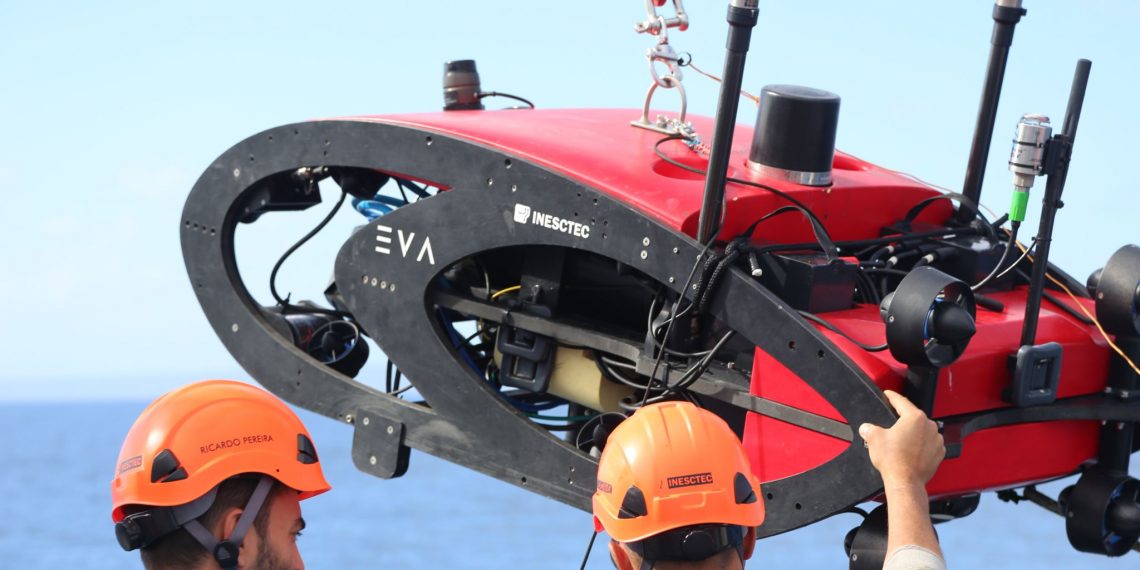Detecting explosive charges on a submarine cable, or signalling and assessing the status of a submarine, located at a depth of 90 meters – with a crew on board, simulating an emergency situation. These are two examples of the tests carried out by INESC TEC, during REPMUS, the world’s largest testing exercise on Unmanned Marine Systems and other emerging technologies, organised by the Portuguese Navy.
Mar Profundo, EVA and Turtle – a research vessel and two underwater robots. Seven days. Three exercises. INESC TEC participated in REPMUS (Robotic Experimentation and Prototyping Augmented by Maritime Unmanned Systems), held in Troia and Sesimbra; the Institute demonstrated the potential of the technologies for critical underwater infrastructure protection actions.
The first exercise aimed to identify a submarine cable, in which explosive charges were placed to simulate an attack. The team aboard the Mar Profundo used the EVA robot to detect and map the cable – 400 meters long and 2.8 centimetres in diameter – and to identify and locate possible threats.
“There are several concerns about digital attacks taking place in the future; we perceive these types of underwater infrastructures – like those use to transmit information – as targets of said attacks. In this sense, we need to prevent them. Robots play a vital role in this scenario because they reach depths that humans simply can’t, favouring the efficiency and safety of these operations”, explained José Miguel Almeida.
According to the INESC TEC researcher, in addition to detecting and mapping a booby-trapped submarine cable, the EVA robot proved to be an excellent tool in another exercise. In 25 minutes, the robot carried out the precision mapping and 3-D reconstruction of the Portuguese Submarine NRP Arpão, located about 90 meters deep, with a crew on board. The goal? To locate and analyse the state of the submarine, simulating an emergency.
“After acoustically receiving a message with the estimated position of the submarine, we had to map and detect the submarine – while on board the Mar Profundo. After the mapping was done, the EVA submerged to carry out a new precision mapping and a 3-D reconstruction, to understand the state of the vessel. It only took us 25 minutes to carry out this task with EVA, mentioned the researcher.
And for the first time, the team was also able to send real-time images collected underwater by the Turtle III Robotic Lander to the Navy Command and Control Centre. How? Through optical communications. “The Turtle dived autonomously, landing on the Setúbal canyon, at approximately 350 meters deep, during a multi-day monitoring mission on the seabed. Then we sent EVA to collect data from Turtle and live streamed images from a camera installed on Turtle for the first time; this way, it was possible to observe, in real time, the images that Turtle collected. We were able to implement the wireless optical communication between the two robots and transmit all the information that Turtle collected to EVA through an optical link, and later relay the information to the Mar Profundo and to land, via 5G”, concluded José Miguel Almeida.
REPMUS took place in September, in Sesimbra and Troia. This is a robotics exercise organised by the Portuguese Navy, and co-organised by the University of Porto (UP), the NATO Centre for Maritime Research and Experimentation (NATO CMRE) and the NATO Maritime Unmanned Systems Initiative (NATO MUSI) – bringing together several entities, with 1400 participants from 26 countries.
The researcher mentioned in this news piece are associated with INESC TEC and IPP-ISEP.










 News, current topics, curiosities and so much more about INESC TEC and its community!
News, current topics, curiosities and so much more about INESC TEC and its community!